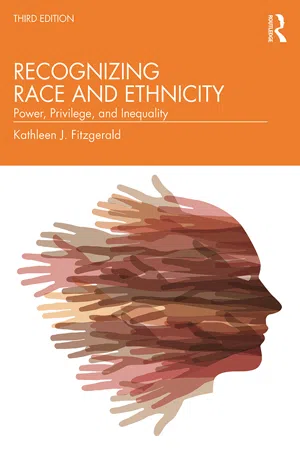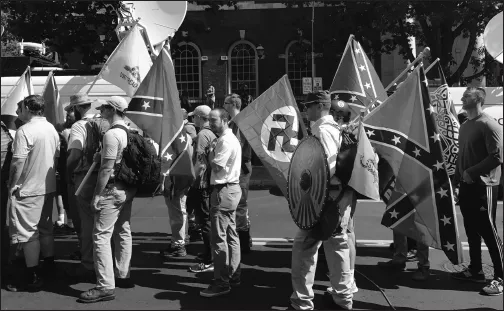![]()
PART ONE
Thinking About Race
![]()
C H A P T E R
1
Taking Account of Race, Racism, and Privilege
CHAPTER LEARNING OUTCOMES
By the end of this chapter, you should be able to:
• Differentiate between race and ethnicity
• Define sociology and the sociological imagination
• Distinguish between different forms of racism
• Understand what is meant by the social construction of race
• Describe demographic shifts in American society along racial/ethnic lines
• Explain how race functions at the level of identities, ideologies, and institutions
• Discuss the Millennial generation’s attitudes on race
As I write this introduction to the third edition of Recognizing Race and Ethnicity, Sacramento County District Attorney Anne Marie Schubert announced that the two police officers who fatally shot African American Stephon Clark almost one year prior, on March 18, 2018, would not face charges in the shooting. Clark was unarmed and shot to death in his grandmother’s backyard as he was being pursued as a vandalism suspect. Police mistook the cell phone Clark was holding for a gun and fired twenty shots at him. A feeling of déjà vu came over me, as I realize the first sentence of the second edition of this text begins with a similar story—the announcement that Caesar Goodson Jr., the sole Baltimore police officer charged with murder in the death of 25-year-old African American Freddie Gray during an encounter with police on April 12, 2015, had been found not guilty.
After a string of similar incidents in which unarmed African Americans—such as Trayvon Martin, Oscar Grant, Michael Brown, Tamir Rice, Eric Garner, Alton Sterling, Philandro Castile, Rekia Boyd, Tanisha Anderson, and so many others—were killed by police or self-proclaimed neighborhood watchmen, it seems hard not to see this as part of a larger pattern. In the face of so many incidences, we must ask, “Is the violence against black bodies a result of isolated incidences which can be reduced to the poor decisions of those involved? Or is there a larger problem at hand—one that indicates that ‘all lives’ do not, in fact, matter?” (Weissinger, Mack, and Watson 2017:1). Police shootings of unarmed African Americans have inspired protests, activism, and the emergence of a new social movement, Black Lives Matter.
While it is still rare for a police officer to be charged and convicted of an on-duty shooting, there are two recent examples where police officers were held accountable for their actions. Chicago police officer Jason Van Dyke, who shot and killed unarmed 17-year-old Laquan McDonald, was found guilty of second-degree murder and received a sentence of six years and nine months, far shorter than the eighteen years prosecutors were seeking. Michael Slager, the North Charleston, South Carolina, police officer who shot and killed unarmed African American Walter Scott, was sentenced to twenty years in prison for his actions in late 2017. In this case, Judge David C. Norton described the shooting as “reckless, wanton and inappropriate” (Blinder 2017).
W. E. B. Du Bois begins his seminal work, The Souls of Black Folk, with the prophetic statement: “The problem of the Twentieth Century is the problem of the color-line” (1989:1). His comment remains true today, but we would instead say the problem of the twenty-first century remains a problem associated with the racial order, the collection of beliefs, suppositions, rules, and practices that shape the way groups are arranged in a society; generally, it is a hierarchical categorization of people along the lines of certain physical characteristics, such as skin color, hair texture, and facial features (Hochschild, Weaver, and Burch 2012). The United States has not resolved the “race problem,” as it has historically been referred to by social scientists, and part of the reason is that white people have never considered it to be their problem to solve. The term race problem implies a problem of racial minorities. Du Bois expresses this implication in his first chapter: “Between me and the other world there is ever an unasked question … How does it feel to be a problem?” (1989:3). Race relations in a society, whether problematic or not, involve all racial groups, including the dominant racial group.
The election of President Barack Obama led to immediate claims in the media that the United States was a postracial society, a society that had moved beyond race, because Obama could not have won the presidency without a significant number of white votes. However, as sociologists point out, Obama may have won the presidential elections in 2008 and 2012, but most whites did not vote for him (Wingfield and Feagin 2010). While Obama won significant majorities of racial minority votes, from 62 percent of the Asian American vote and 66 percent of the Latino vote to 95 percent of the black vote, he won only 43 percent of the white vote in 2008 (Wingfield and Feagin 2010). The kind of opposition he faced while governing was virulent and unlike anything past presidents have experienced. For instance, he is the only president to have his birthright questioned. Perhaps even more disturbing, the US Secret Service reported approximately thirty death threats against Obama daily, which is four times the number made against the previous president (Feagin 2012).
The election of Donald Trump stifled any discussion of the United States as postracial, as he began his political career by promoting the idea that President Obama was not born in the United States and thus was not a legitimate president, and he made racism a central aspect of his campaign and presidency (see Chapter 13). A few examples include his campaign kick-off when he referred to Mexican immigrants coming to the US as rapists and as bringing crime and drugs, which he followed with, “some, I assume, are good people” (Silva 2018). He later criticized federal judge Gonzalo Curiel, who is of Mexican descent and was born in Indiana, claiming he could not possibly be impartial in his decision making because he was Mexican. Perhaps most surprising was when he not only refused to condemn the white nationalists’ deadly violence at the Unite the Right rally in Charlottesville, VA, in 2017 but also claimed that there were good people on both sides. The white supremacist who murdered forty-nine people gathered for worship at a mosque in Christchurch, New Zealand, in March of 2019 cited President Trump as an inspiration in his manifesto, describing him as a symbol of “renewed white identity and common purpose.” While Donald Trump has claimed that he is the “least racist person that you have ever met,” his own comments and the avowed support he receives from white supremacists challenge that account (O’Connor and Marans 2016). Ta-Nehisi Coates counters Trump’s claim, stating, “In Trump, white supremacists see one of their own … To Trump, whiteness is neither notional nor symbolic but is the very core of his power” (2017:4).
While much has changed over the last century in terms of race, race remains a central organizing principle of our society, a key arena of inequality, and the subject of ongoing conflict and debate. Race also influences our identities, how we see ourselves. Ongoing evidence of the continuing significance of race manifests in both significant and obscure ways, as the following exemplify:
• White nationalists held a “Unite the Right” rally in Charlottesville, VA, in August of 2017 and were met by antiracist counter protesters. Violence erupted and one counter protester, Heather Heyer, was killed in the conflict.
• On July 17, 2019, a noose was found on Stanford University’s campus near a residence hall where a group of largely minority high-school students were staying for a summer program (Griffith 2019).
• The State of New York recently convicted a white supremacist of terrorism; this is the first time in the state’s 231-year history that a white supremacist was convicted on terrorism charges (Kalmbacher 2019).
• For the first time in American history, the November 2018 elections saw two Native American women elected to the House of Representatives. Sharice Davids, a member of the Ho-Chunk nation, will represent Kansas and Deb Haaland, a Laguna Pueblo, will represent New Mexico.
• Numerous incidences of white women calling the police on black people for nonexistent offenses have drawn national media attention during 2018–2019. These include an incident at a corner store in Brooklyn where 53-year-old Teresa Klein called the police on a black child and accused him of sexual assault when his backpack brushed up against her as he walked past (Phillips 2018). Another involved a black man who was detained by a white police officer at gunpoint as he picked up trash in front of the building where he lived and worked in Boulder, CO (Stevens and Mervosh 2019).
• Rachel Dolezal ignited a nationwide debate in 2015 about racial identity when it was discovered that she, a woman born to two white parents, identified as black and had been passing as black for most of her adult life.
• According to the Institute for Women’s Policy Research, women earn 81.1 cents for every dollar a man earns; but for black women, that pay gap is even greater. Black women earn 66.8 cents for every dollar white men earn, even when they have the same education, skills, and experience (Rankin 2016).
• After a sixty-two-year court battle over school integration, on May 18, 2016, the middle schools and high schools of Cleveland, Mississippi, were ordered by a judge to desegregate.
• Democratic Virginia Governor Ralph Northam faced demands for his resignation when a racist medical school yearbook photo emerged. As he admitted to wearing blackface during that time period, the Attorney General of the state, Mark R. Herring, also acknowledged wearing blackface at a party as an undergraduate. As of this writing, neither official has resigned over the scandal (Martin and Blinder 2019).
• LGBTQ people of color face disproportionate rates of violent victimization (Mogul, Ritchie, and Whitlock 2011). The year 2015 was the most violent year on record for transgender people: twenty-two transgender people were murdered, and nineteen of those were people of color (Fitzgerald 2017; Meyer 2015).
THE SIGNIFICANCE OF RACE
Despite the undeniable racial progress that has been made during the twentieth century, ongoing racism exists and even harkens back to the racism of earlier eras. As the opening vignette describes, being a young person of color in the United States can be lethal. Oscar Grant, Michael Brown, Eric Garner, Tamir Rice, Alton Sterling, Philandro Castile, Stephon Clark, and Jamar Clark are just a few of the black men who have been killed at the hands of police in the last few years. In fact, some have referred to the police shootings of unarmed black men as a “blatant disregard for black and brown bodies” and an example of “modern day lynching” (Embrick 2015:836–837). After the acquittal of George Zimmerman in the shooting death of Trayvon Martin, three African American women, Alicia Garza, Patrisse Cullors, and Opal Tometi, began an online campaign known as #BlackLivesMatter (#BLM). This has since grown into an international social movement, moving the hashtag from social media to the streets with, according to Garza, thirty-three chapters in the US and some abroad. Their initial goal was to draw attention to the injustices African Americans face, particularly at the hands of police. Ultimately, their objectives include celebrating blackness in a nation that denigrates it (see Chapter 6).
While Black Lives Matter activism has helped focus necessary attention on police killings of unarmed black men, the killings of African American women, LGBTQ people of color, Native Americans, and Latinos have generated less media attention. Rekia Boyd, Sandra Bland, Gynnya McMillen, and Ty Underwood are just some of the African American or LGBTQ women of color recently killed, most while in police custody. The #SayHerName movement has emerged as a gender-inclusive racial justice movement to rectify this oversight.
I M A G E 1 ...

